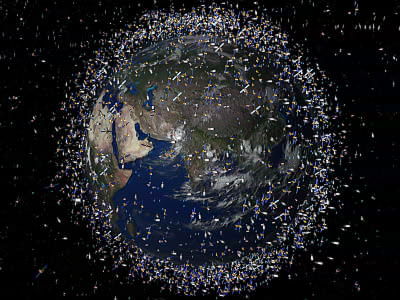A sci-fi technology that uses a tractor beam to attract and collect space debris could become a reality

In science fiction works, we often see depictions of shooting down incoming meteorites with beams emitted from the Earth, or moving objects in space with
Sci-fi inspired tractor beams are real, and could solve a major space junk problem | Live Science
https://www.livescience.com/space/space-exploration/sci-fi-inspired-tractor-beams-are-real-and-could-solve-the-major-problem-of-space-junk

A tractor beam is a term that appeared in the 1931 science fiction novel ' Spacehounds of IPC ' by Edward Elmer Smith, also known as the 'father of space opera. ' It is a device that transports objects far away in space by irradiating them with a beam. In fiction, tractor beams are sometimes used to capture enemy spacecraft or recover destroyed materials.
Experts say that tractor beams could be used to collect space debris.
The problem of space debris, such as fragments of rockets and artificial satellites, is becoming more serious, and various problems have occurred, such as a case where a piece of space debris flying at high speed collided with the International Space Station , damaging a robot arm, and a case where an object suddenly fell on a private house and NASA acknowledged that it was 'debris dumped by the International Space Station.' Methods proposed to dispose of the countless floating space debris include ' shooting in a harpoon ' and attempts to collect it by wrapping it in a ' membrane-type spacecraft ,' but the removal of space debris has not progressed smoothly worldwide.
Is there a way to collect 'space debris' floating in space? - GIGAZINE

According to experts, the technology under development, called 'electrostatic tractor,' which attracts space debris with a beam, aims to attract defunct satellites far away from Earth's orbit and let them drift in that harmless area to prevent the risk of them falling to Earth as space debris or colliding in Earth orbit. Although it does not completely solve the problem because space debris will remain in space, experts say it has several advantages over other space debris removal methods proposed so far and could be a valuable tool to tackle the serious space debris problem.
'The science is almost there, but funding is lacking. Prototypes could cost hundreds of millions of dollars to build, and a full-scale working version could be even more expensive. But if we can get past the funding hurdles, the tractor beam could be operational within 10 years,' Kayleigh Champion, a doctoral student in the Department of Aeronautics and Astronautics at the University of Colorado Boulder and project researcher for the electrostatic tractor, told Live Science. According to Champion, Hanspeter Schaup, a professor in the department, started a project to remove space debris after the first major satellite collision in 2009 to prevent a repeat.
There are other efforts to use lasers to deal with space debris. In 2018, Russia's state-run space development company announced plans to shoot down space debris using a giant laser cannon with a diameter of 3 meters. It is believed that the space debris will break down and break into small pieces, which will fall to Earth and burn up in the atmosphere.
Russia tries to dispose of space junk with laser cannons - GIGAZINE

By Jasper Nance
On the other hand, Shoup's concept is similar in that it uses a laser beam, but the purpose is to move space debris rather than break it up or shoot it down. According to Champion, the tractor beam is fired from a spacecraft equipped with an electron gun and charges space debris floating in geostationary orbit around the Earth with negative electrons. By charging the spacecraft positively, the negatively charged space debris is attracted by electrostatic attraction, and they become 'sticky' like a magnet while remaining about 20 to 30 meters away, allowing the spacecraft to attract the space debris without directly touching it. The space debris is then ideally drawn into a ' graveyard orbit ' away from the Earth where there is little risk of collision or falling, and continues to drift safely.
Project researcher Julian Hammar points out that the towing spacecraft and space debris need to be separated to prevent a collision, and given the limitations of electron beam technology, the electrostatic attraction between the spacecraft and the space debris will be extremely weak. Therefore, the spacecraft needs to move quite slowly to move the space debris, and it may take more than a month to completely move one piece of space debris. 'This is the main difference between the tractor beam of science fiction, which quickly attracts objects, and reality,' Hammar says.
While technically advanced and time-consuming, the electrostatic tractor also has a major advantage. Unlike harpoon or robotic arm capture methods, the electrostatic tractor has no contact with the spacecraft. If the spacecraft is damaged by contact with space debris, new space debris will be created and the problem will only worsen, but the risk of this is extremely low with the non-contact electrostatic tractor, and the mission can be completed without generating new space debris. The image below illustrates the non-contact capture method shown by Shoup.

Electrostatic tractors are too slow to be practical for use in removing all space debris, even small pieces, from geostationary orbit, and are too expensive with current technology to be of any practical use. Scientists are currently running relatively inexpensive, small-scale simulations while they wait to secure funding for the first missions.
Related Posts:
in Science, Posted by log1e_dh





